
The Navy Department Library
Chapter VIII. The Salvage Boat
* * * * *
When a boat is broached in a heavy surf and water is cascading over its gunwales with every wave, the salvage boat is a welcome sight. The salvage boat flies a flag, by which she can be identified, at her bow* and is equipped to tow stranded LCVP's or LCM(3)'s off the beach in short order. She is the proverbial "friend in need" and plays an important part in landing operations--especially when the surf is high and ugly.
At present in "amphib" most salvage boats are one of several types. They may be the LCP(L), the LCP(R), which is a landing boat with a narrow ramp, or an LCVP or LCM. In some cases heavier non-landing craft also may be assigned to assist in salvage of landing craft. These include such ships as mine sweepers and tugs.
The crew and equipment of the salvage boat. The salvage boat is manned by an especially
___________
* A screened signal light is used at night.
--56--
trained crew, including men who are experts in handling lines. The size and nature of the crew varies with the circumstances. A crew may consist of an Officer-in-charge, a coxswain, an engineer, two deck-hands (one of whom is a signalman), a radioman, and hospital corpsman. Carpenters, electricians, shipfitters, motor machinists, gunners, and other specialists may be included as needed.
To do its job safely and effectively, the crew is trained in boat handling, both practical and theoretical, in piloting, surf operations, marlinspike seamanship, the use of towing equipment, and shoreward salvage (including the use of such vehicles as the bulldozer and Jeheemy*). The specialists, such as the carpenter and electrician, are prepared for the various phases of salvaging.
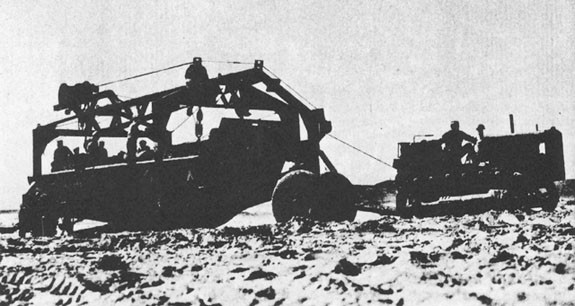
The equipment carried by the salvage boat includes most of the items found aboard the LCVP plus additional gear. Each boat may not carry all of the equipment listed below at all times, but the items are essential and should be available in at least one boat when an operation is in progress.
Major equipment carried for repairing serious damage to boats includes: (1) a 300 ampere gasoline or diesel driven portable arc welding outfit, (2) an oxy-acetylene welding outfit, (3) a portable gasoline engine driven salvage pump, and (4) shallow water diving gear. Small items are: (1) wire cutters, (2) propeller puller, (3) carpenter's and machinist's hand tools, (4) fire-fighting equipment, (5) miscellaneous repair and replacement parts such as: hose and hose clamps, starters, solenoid switches, extra storage batteries, propellers, sheet lead and white lead, salt water circulating pumps, injectors, and spare oil and water.
Towing gear commonly found on the salvage boat consists of: (1) a 150 fathom five-inch towing line, (2) three heaving lines, (3) a shoulder line-throwing gun, (4) wire straps and a towing bridle.
Lastly, a portable, two-way radio, signal lights and flags, portable loud speaker, and binoculars are kept aboard to speed up communications.
The salvage boat's job. The salvage boat and its crew have three important responsibilities. First, the sea approaches to a beach must be kept clear as the boat waves speed shoreward. Disabled "VP's" and "M(3)'s" are to be towed clear as quickly as humanly possible. Second, troops and equipment from these disabled boats are to be transferred to the beach immediately
___________
* The Jeheemy is a type of portable crane hauled along the beach by a tractor.
--57--
so that the landing operation can proceed according to plan. Third, damaged and broached boats are to be salvaged.
In a typical landing action the salvage boat is stationed in the rendezvous area as H-hour draws near. When the first wave of boats peels off and heads for the shore the salvage boat follows, close behind with its flag flying. She moves in close to the breaker line and there awaits developments. During this time communication is maintained by the radioman so that any calls for assistance can be answered speedily. The salvage crew keeps on the alert to assist boats which they see are in difficulty and stand by for orders from the Beachmaster who directs salvage boats' operations.
Ordinarily, top priority is given to keeping the sea approaches clear and to the transfer of troops and supplies to the beach. Disabled and stranded boats are towed clear and anchored or returned to the transport from which they came if time permits. Badly crippled boats are "turned over to Davy Jones." The salvage boat hauls them to deep water, strips off equipment, and sinks them.
Since the Beachmaster is responsible for getting boats off the beach promptly, he works closely with salvage crews. If the going is tough and many LCVP's and LCM(3)'s are broached or disabled the beachmaster may draft additional salvage boats. Often one or two trained men from a regular salvage outfit may be assigned to direct such emergency salvage and towing activities.
Salvage Procedures
Good salvage work calls for good judgment. The main purpose of salvage is not merely to free a stranded or disabled boat from the beach. The real objective is to keep the beach clear for incoming waves of boats. Experienced salvage crews never lose sight of the more important purposes of their work. They are careful to avoid becoming so enthusiastic about a rescue that they get in the way of groups of LCVP's or LCM(3)'s enroute to the shore.
Freeing a broached or stranded landing boat is the most common salvage operation. The need for haste is great when a boat swings broadside to the shore. The longer she lies there the more likely she is to be damaged. Also, when the surf is running high, unpleasant things can happen to the crew of a broached boat. Men have been injured and even killed when their boat capsized, foundered, pitched so wildly that they were tossed clear overboard from the cargo space or cockpit.
If you are aboard a broached boat, keep afloat. When water tumbles over the stern side bail steadily with buckets, helmets or a container at hand. The better the boat floats the easier the salvaging. Keep the engine running at all costs. Once the diesel gives up your are helpless, even if freed from the beach.
The salvage boat will come in toward the shore as promptly as possible to begin the salvage operation. Just what steps are taken to free a stranded boat vary according to the circumstances. Successful salvaging depends upon the ability of the crew to work out the best procedures for each particular job. In the following paragraphs salvage operations which are recommended under various conditions are set forth. However, when you are engaged in salvaging remember that you will need to adapt your efforts to fit the work at hand.
When the surf is light, the salvage boat must back in far enough to pass the towline to members of the crew of the stranded boat who wade out to receive it. An even better approach, when circumstances permit, is for the salvage crew to remain outside the breaker line and let another landing boat beach and pass a towline to the stranded boat by hand or heaving line.
If the beach is flat and the surf is breaking well out the salvage boat may be beached and a line passed. On the other hand, when the surf is breaking close inshore, or the beach is steep, the salvage crew approaches the shore on the weather (windward) side of the broached boat and does not beach. Instead a heaving line is thrown and the heavier towing line hauled aboard the stranded boat. Approaching from windward enables a deckhand to throw the heaving line more easily. Also, the distance between the boats decreases as the salvage boat is set toward the stranded boat by the wind. Usually this allows time for a cast with a second heaving line if the first falls short.
In a heavy surf it may be necessary to stand off and use the line throwing gun so that a tow line attached to a messenger* can reach a broached boat. Also, in certain situations, the salvage boat may anchor outside the breakers with the anchor line at the bow. This line is then paid out to let the salvage boat drop astern until close enough inshore to pass a line to the stranded boat. A strain on the anchor
___________
* A messenger is a light line by means of which a heavier line (to which it is secured) may be hauled aboard.
--58--
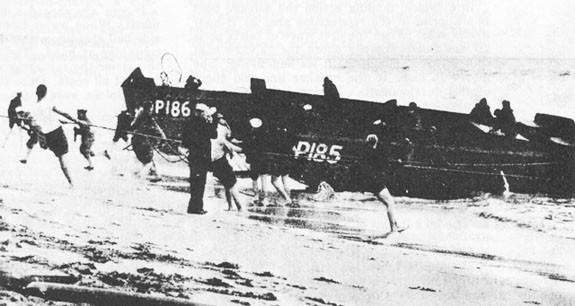
line will hold the bow of the salvage boat to the sea.
An anchor and line are used as suggested only if absolutely necessary. The procedure is generally undesirable because it is difficult for the salvage crew to haul in the anchor line with sufficient speed once their boat begins to move seaward in the direction of the anchor.
Once a towline has been passed there are a number of rules to be observed by the salvage crew and the crew of the broached boat.
- The towline is paid out carefully to avoid fouling the screws of either the salvage or the stranded boat.
- The towline is made fast to the centerline bollards at the stern of both boats. If the stranded boat is not equipped with such a bollard a bridle* is made fast to the two Sampson posts on the quarters of this boat. A bridle is always used when freeing an LCM.
- A broached boat is never towed from one quarter fitting. This is both dangerous and inefficient.
- The salvage boat never attempts to tow with the line led from its bow.
- When the salvage boat is beyond the breaker line a steady strain is put on the towline. Slack is taken up without jerking and full throttle ordinarily is not used although the strain is continued. Due to the strain the stranded boat will come off the beach a few inches as each sea raises her. Be patient if the broached boat does not break free on the first few pulls. Keep trying to free her until you succeed or are ordered from the beach to stop.
- The coxswain of the broached boat keeps her in forward gear. There are two main reasons for this. First, as the coxswain guns the engine forward while a wave is receding the discharge current blasts sand from around the rudder and skeg. This prevents rudder damage and enables the boat to draw off the beach without dragging on or digging into the sand. Second, keeping the engine in forward preserves the strain on the towline and helps to keep the stern from going down.
___________
* A bridle is a span of rope or cable, each end of which is secured to Sampson posts or mooring bitts on both stern quarters during salvage operations. The towline is made fast to the center of the bridle.
--59--
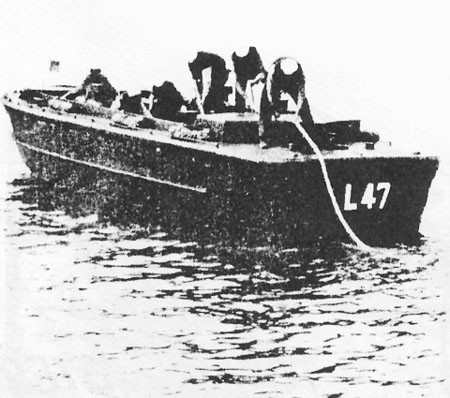
- The boat freed from the beach is towed until clear of the surf*. Lines are cast off with care (unless the tow is crippled) and the salvage boat's crew fakes down the towline after moving clear of incoming boat waves.
There are few if any hard-and-fast rules for salvaging. The steps given above merely serve as examples of common procedures followed in "typical" situations. You will soon discover that no salvage problem is exactly like another, even though some are similar.
The nature of the beach, the way in which a boat has broached, enemy positions in a real attack, wind, surf, currents, the equipment at hand, and many other factors will determine what is done. A few examples may serve to make this clear.
When a boat is stranded and lying almost parallel to the beach it may be desirable to place a towline on the bow. Sometimes that boat can be swung around this way with its stern serving as a pivot. When this is done, the line is slipped under the bow and brought up around on the shoreward side and fastened to a forward bitt or cleat. When hauled free the boat is towed out to sea bow first.
On a steep beach, made treacherous by a heavy backwash and current, the best salvage approach may be for the salvage boat to land at some distance from the stranded "VP" or tank lighter. The towline then may be carried across the beach by hand and secured before the salvage boat retracts. This method of passing the line lessens the danger that the heavy backwash will carry the towing line into the screws of either or both vessels.
Ingenuity--quick and clever thinking--in figuring out the best thing to do in a tight spot is a priceless aid to the salvage crew. One seaman, with more than his share of wits, thought up an intelligent and simple salvage trick some years ago. It is now often used.
He was in a salvage boat which was attempting to rescue another small boat aground on a rocky strip of shore and in danger of being smashed to water-soaked kindling. The salvage crew could neither land nor get in close enough to heave a line. The quick-thinking crewman came through with the idea of bending two heaving lines together, attaching one end to a life-ring, and letting the ring float in through the surf. This did the trick. A towing line, secured to the heaving line, reached the stranded boat and she was hauled free, somewhat worse for the pounding but sound enough to be patched up.
Towing Alongside and Astern
There are two methods of towing: alongside and astern. Both are simple if the boat crews know where to attach the lines and how to make them secure.
The alongside method is used only for short distances and when it is desirable to place the tow alongside a ship or dock. For a long run, particularly when the weather is bad, the astern method is more satisfactory.
- The boat to be towed is approached slowly from the quarter. Fenders should be out and bow and stern lines ready for use.
- When the towing boat is alongside the tow's quarter, a line of three-inch manila is run from the bow cleat of the towing boat to the stern post of the tow (See drawing on page 61.) Then a bow or anti-broaching line is passed to the tow to serve as a forward breast or steering line. Next a line is run from the Sampson post (or stern bollard) of the towing boat to the tow's outboard quarter as shown in the drawing.
- All lines are hauled taut and secured before the boats are ready to proceed.
____________
* At times, when the beach is steep and the surf is unusually high, it may be necessary to build temporary decking of wood and canvas over the after compartment of the LCVP to prevent swamping when the boat is towed through the surf.
--60--
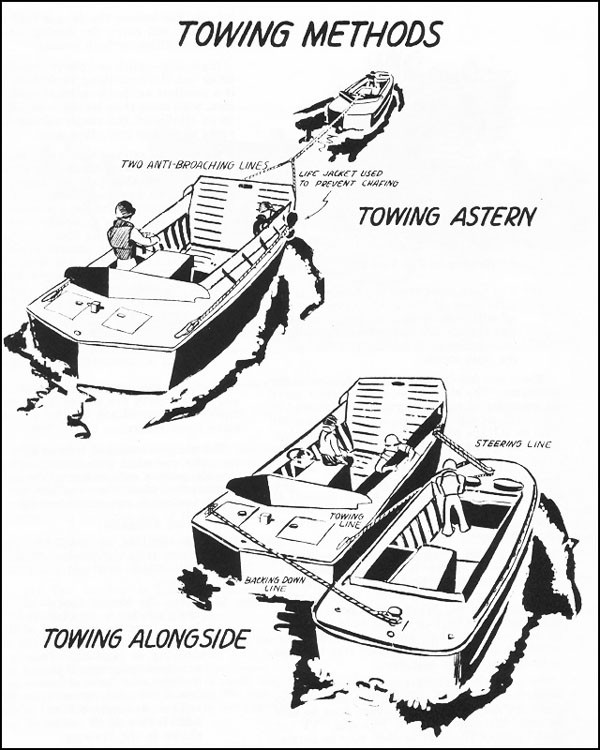
--61--
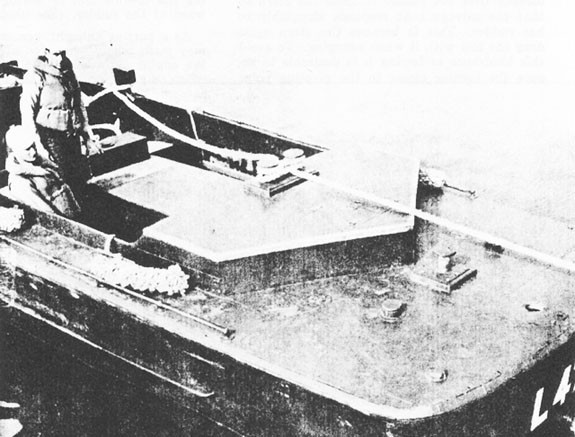
A five-inch manila line, a wire or manila bridle, and two shackles are used when towing astern. When this gear is ready:
- The tow is approached from astern and at a 20 to 30 degree angle to the heading of the tow.
- When alongside, a towing line is passed over by means of a heaving line. The heavier line is hauled aboard and the bridle is shackled in place.*
- The towboat moves ahead slowly, paying out line.
- The towline is secured to the Sampson post or towing bollard.
- The towing boat moves ahead carefully to avoid sudden jerks which might part the line. To enable the screw to get a good bite in the water it may be necessary to shift weight and crew members aft. Also, towing is easier if the line is adjusted so that the tow can ride the crest of the second or third stern wave of the towing boat's wake.
In waters where a current runs parallel to the beach, two salvage boats may be needed to free a broached boat. The second salvage boat serves to keep its companion boat from swinging broadside to the waves as it works to free the stranded boat. In this tandem type of tow a line is run from the stern of the seaward salvage boat to the bow of her sister closer to shore. Once the stranded boat is afloat both salvage boats can help to pull her outside the surf line.
___________
* In a pinch the anti-broaching or bow and stern lines can be used to form a towing bridle. This is done by securing the bitter ends of the lines together with two bowline knots. Then secure the towline to the anti-broaching line by means of a third bowline. Pass all three lines over the ramp of the stranded boat. After the towboat takes a slight strain, use life jackets to keep the lines from chafing against the ramp of the broached boat.
--62--
When a towline from a salvage boat leads directly over her rudder it binds the stern so that the salvage boat responds sluggishly to her rudder. This is because the stern must drag the tow with it when swinging. To avoid this hindrance in towing it is desirable to secure the towline closer to the pivoting point of the salvage boat. This can be done by making the towline fast to towing bitts well forward of the rudder. (See photograph.)
As a parting thought, remember that haste may make waste when you are towing. Keep the engine throttled down! Lines part easily when an eight-ton load is the tow.
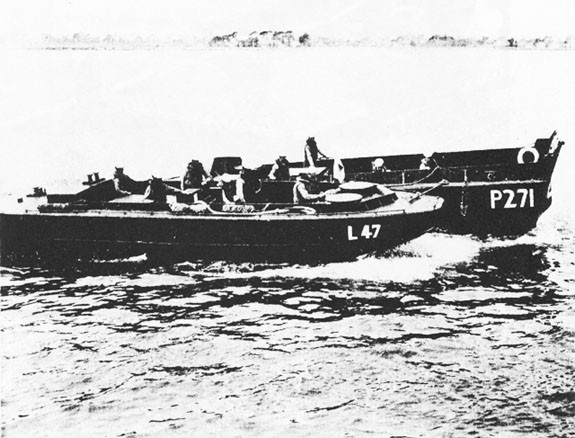
--63--
[End of Chapter 8]



